A) 20 W
B) 40 W
C) 160 W
D) 200 W
E) 400 W
Correct Answer

verified
Correct Answer
verified
Multiple Choice
A hollow cylinder of mass M and radius R rolls down an inclined plane. A block of mass M easily slides down an identical inclined plane. Complete the following statement: If both objects are released at the same time from the top of their inclined planes,
A) the cylinder will reach the bottom first.
B) the block will reach the bottom first.
C) the block will reach the bottom with the greater kinetic energy.
D) the cylinder will reach the bottom with the greater kinetic energy.
E) both the block and the cylinder will reach the bottom at the same time.
Correct Answer

verified
Correct Answer
verified
Multiple Choice
A 3.0-kg ball and a 1.0-kg ball are placed at opposite ends of a massless beam so that the system is in equilibrium as shown. Note: The drawing is not drawn to scale. What is the value of the ratio of the lengths, b/a? 
A) 2.0
B) 2.5
C) 3.0
D) 4.0
E) 5.0
Correct Answer

verified
Correct Answer
verified
Multiple Choice
A compact disc rotates about its center at constant angular speed. Which one of the following quantities is constant and non-zero for a dust particle near the edge of the disc?
A) linear velocity
B) torque about the center of the disc
C) centripetal acceleration
D) angular momentum
E) angular acceleration
Correct Answer

verified
Correct Answer
verified
Multiple Choice
Which one of the following statements most accurately describes the center of gravity of an object?
A) It is the point where gravity acts on the object.
B) It is the point where all the mass is concentrated.
C) It must be experimentally determined for all objects.
D) It is the point on the object where all the weight is concentrated.
E) It is the point from which the torque produced by the weight of the object can be calculated.
Correct Answer

verified
Correct Answer
verified
Multiple Choice
A solid sphere rolls without slipping along a horizontal surface. What percentage of its total kinetic energy is rotational kinetic energy?
A) 33 %
B) 50 %
C) 12 %
D) 75 %
E) 29 %
Correct Answer

verified
Correct Answer
verified
Multiple Choice
Complete the following statement: When a net torque is applied to a rigid object, it always produces a
A) constant acceleration.
B) rotational equilibrium.
C) constant angular velocity.
D) constant angular momentum.
E) change in angular velocity.
Correct Answer

verified
Correct Answer
verified
Multiple Choice
A ceiling fan has five blades, each with a mass of 0.34 kg and a length of 0.66 m. The fan is operating in its "low" setting at which the angular speed is 9.4 rad/s. If the blades can be approximated as uniform thin rods that rotate about one end, what is the total rotational kinetic energy of the five blades?
A) 35 J
B) 29 J
C) 23 J
D) 17 J
E) 11 J
Correct Answer

verified
Correct Answer
verified
Multiple Choice
A 4.0-kg ball moves in a straight line at 8.0 m/s as shown in the figure. At the instant shown, what is its angular momentum about the point P? 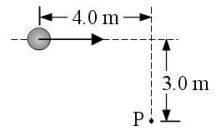
A) 33 kg . m2/s
B) 85 kg . m2/s
C) 110 kg . m2/s
D) 160 kg . m2/s
E) zero kg . m2/s
Correct Answer

verified
Correct Answer
verified
Multiple Choice
A rider on a motorcycle that has a mass of 195 kg is traveling with a speed of 24 m/s. Each of the two wheels of the motorcycle has a radius of 0.29 m and a moment of inertia of 0.46 kg . m2. What is the approximate total rotational kinetic energy of the wheels?
A) 800 J
B) 1100 J
C) 1500 J
D) 3200 J
E) 4100 J
Correct Answer

verified
Correct Answer
verified
Multiple Choice
Three objects are attached to a massless rigid rod that has an axis of rotation as shown. Assuming all of the mass of each object is located at the point shown for each, calculate the moment of inertia of this system. 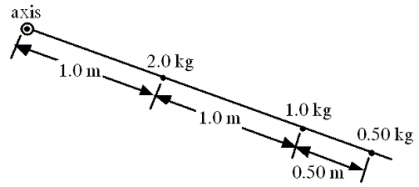
A) 1.3 kg . m2
B) 3.1 kg . m2
C) 5.3 kg . m2
D) 7.2 kg . m2
E) 9.1 kg . m2
Correct Answer

verified
Correct Answer
verified
Multiple Choice
A ball of mass M moves in a circular path on a horizontal, frictionless surface. It is attached to a light string that passes through a hole in the center of the table. If the string is pulled down, thereby reducing the radius of the path of the ball, the speed of the ball is observed to increase. Complete the following sentence: This occurs because 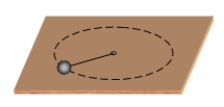
A) the linear momentum of the ball is conserved.
B) it is required by Newton's first law of motion.
C) the angular momentum of the ball is conserved.
D) the angular momentum of the ball must increase.
E) the total mechanical energy of the ball must remain constant.
Correct Answer

verified
Correct Answer
verified
Multiple Choice
Consider the following three objects, each of the same mass and radius:  All three are released from rest at the top of an inclined plane. The three objects proceed down the incline undergoing rolling motion without slipping. In which order do the objects reach the bottom of the incline?
All three are released from rest at the top of an inclined plane. The three objects proceed down the incline undergoing rolling motion without slipping. In which order do the objects reach the bottom of the incline?
A) 3, 1, 2
B) 2, 3, 1
C) 1, 2, 3
D) 3, 2, 1
E) All three reach the bottom at the same time.
Correct Answer

verified
Correct Answer
verified
Multiple Choice
Two equal spheres, labeled A and B in the figure, are attached to a massless rod with a frictionless pivot at the point P. The system is made to rotate clockwise with angular speed on a horizontal, frictionless tabletop. Sphere A collides with and sticks to another equal sphere that is at rest on the tabletop. Note: the masses of all three spheres are equal. What is the angular speed of the system immediately after the collision? 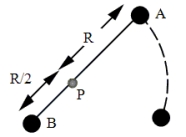
A)
B) 0.82
C) 0.60
D) 0.56
E) 0.29
Correct Answer

verified
Correct Answer
verified
Multiple Choice
A string is wrapped around a pulley of radius 0.05 m and moment of inertia 0.2 kg . m2. If the string is pulled with a force  , the resulting angular acceleration of the pulley is 2 rad/s2. Determine the magnitude of the force
, the resulting angular acceleration of the pulley is 2 rad/s2. Determine the magnitude of the force  .
. 
A) 0.4 N
B) 2 N
C) 8 N
D) 16 N
E) 40 N
Correct Answer

verified
Correct Answer
verified
Multiple Choice
A massless frame in the shape of a square with 2-m sides has a 1-kg ball at each corner. What is the moment of inertia of the four balls about an axis through the corner marked O and perpendicular to the plane of the paper? 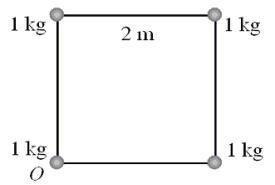
A) 4 kg . m2
B) 8 kg . m2
C) 10 kg . m2
D) 12 kg . m2
E) 16 kg . m2
Correct Answer

verified
Correct Answer
verified
Multiple Choice
A solid sphere and a hollow sphere each of mass M and radius R are released at the same time from the top of an inclined plane. Which one of the following statements is necessarily true?
A) The solid sphere will reach the bottom first.
B) The hollow sphere will reach the bottom first.
C) Both spheres will reach the bottom at the same time.
D) The solid sphere will reach the bottom with the greater kinetic energy.
E) The hollow sphere will reach the bottom with the greater kinetic energy.
Correct Answer

verified
Correct Answer
verified
Multiple Choice
Consider the following four objects: a hoop, a flat disk, a solid sphere, and a hollow sphere. Each of the objects has mass M and radius R. The axis of rotation passes through the center of each object, and is perpendicular to the plane of the hoop and the plane of the flat disk. Which of these objects requires the largest torque to give it the same angular acceleration?
A) the solid sphere
B) the hollow sphere
C) the hoop
D) the flat disk
E) both the solid and the hollow spheres
Correct Answer

verified
Correct Answer
verified
Multiple Choice
Which one of the following statements concerning the moment of inertia I is false?
A) I may be expressed in units of kg .m2.
B) I depends on the angular acceleration of the object as it rotates.
C) I depends on the location of the rotation axis relative to the particles that make up the object.
D) I depends on the orientation of the rotation axis relative to the particles that make up the object.
E) Of the particles that make up an object, the particle with the smallest mass may contribute the greatest amount to I.
Correct Answer

verified
Correct Answer
verified
Multiple Choice
A string is tied to a doorknob 0.72 m from the hinge as illustrated in the figure. At the instant shown, the force applied to the string is 5.0 N. What is the magnitude of the torque on the door? 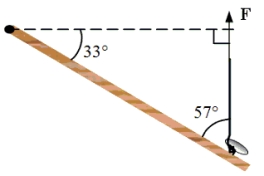
A) 2.1 N. m
B) 3.0 N . m
C) 1.0 N . m
D) 0.78 N . m
E) 0.60 N . m
Correct Answer

verified
Correct Answer
verified
Showing 21 - 40 of 57
Related Exams